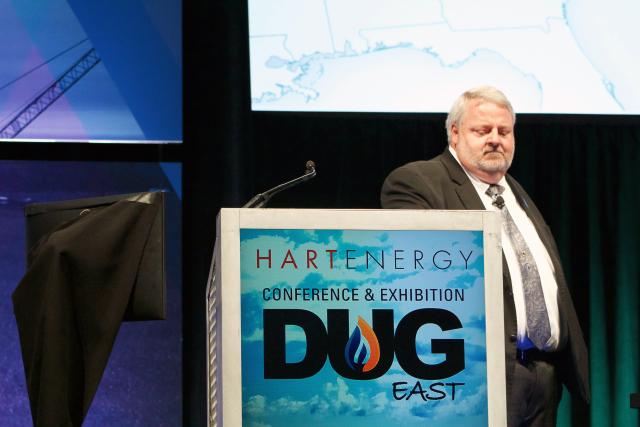
Wally Kandel, Shale Crescent USA co-founder and senior vice president at Solvay Specialty Polymers USA LLC, spoke on the demand spotlight panel at Hart Energy's DUG East Conference and Exhibition. (Source: Len Vermillion/Hart Energy)
PITTSBURGH—Thwarted by infrastructure and environmental obstacles, the Appalachian region has still managed to gain an edge over the Permian Basin as far as natural gas production goes.
Since 2008, Appalachia has accounted for 26.5 billion cubic feet per day (Bcf/d) of natural gas production—85% of production growth across the U.S.— according to a Shale Crescent USA report presented at Hart Energy’s recently held DUG East Conference and Exhibition. The report found that the Permian Basin was responsible for 2.3 Bcf/d.
Shale Crescent USA is a non-profit organization whose mission is to encourage business growth along the Ohio River Valley based upon low natural gas prices.
“People just can’t conceive how big we are up here. They can’t conceive that we’re almost as big as the Permian; they don’t think of us like that if they think of us at all,” Jerry James, co-founder of Shale Crescent USA and president at Artex Oil Co., said.
Despite impressive production growth, the basin is being overlooked for the Gulf Coast as the set up shop for petrochemical plants
“In order to get a manufacturer to come here, you have to prove to them it is more profitable than anywhere else that they can build…they are like us, they are driven by profits,” James said.
RELATED ARTICLE: Mastering Margins, Tapping Resources, Overcoming Challenges In Appalachia
Geographically, Ohio, Pennsylvania and West Virginia are ideal for petrochemical profitability, according to Wally Kandel, Shale Crescent USA co-founder and senior vice president at Solvay Specialty Polymers USA LLC. Building within Columbus, Pittsburgh and Charleston as opposed to the Gulf Coast, Kandel said, would pose a 32% cost advantage.
“The truth is that if you’re really concerned about petrochemical profitability, you ought to be building in Shale Crescent USA because there are big opportunities here,” he said. “Over a 20-year life, you’re going to make a billion dollars more building the facility here.”
RELATED VIDEO: HART ENERGY CONNECT: PIOGA On State Of Pennsylvania Natural Gas
Additionally, Kandel said the location offers lower transportation costs to the majority of the U.S. market.

The Klaber Group speaking at DUG East.
“It’s not the first place you think of to build this type of infrastructure, but that’s why it is so important for us to make it easier to do than it is perceived to be and really have these three states act as one market similar to what the Gulf has achieved,” Kathryn Z. Klaber, managing partner, The Klaber Group, said on the supply and demand panel at DUG East.
To lure in more natural gas producers and independent companies, both James and Klaber stressed that additional capacity and the ability to network nationally would need to be achieved.
“As producers, our number one problem is money. We’re not very profitable as an industry because we have supply ahead of demand,” James said. “When this industry was founded we were on the demand side as an industry, and we need to get back to that point or we’re never going to solve our problems. Almost every other problem we can solve with money, but until we get the demand up we’re not going to solve our primary problem.”
Incoming investment partnered with the geographical advantages warrants Appalachia as the ideal candidate for expansion of the U.S. natural gas market.
“We have the capacity, just with the Marcellus production, for three more ethane crackers here with another one from the Utica,” Klaber said. “That doesn’t mean that capital will find its way here, but we’re certainly in the position where the value proposition from that type of investment is very important to the region.”
Recommended Reading
For Sale, Again: Oily Northern Midland’s HighPeak Energy
2024-03-08 - The E&P is looking to hitch a ride on heated, renewed Permian Basin M&A.
E&P Highlights: Feb. 26, 2024
2024-02-26 - Here’s a roundup of the latest E&P headlines, including interest in some projects changing hands and new contract awards.
Gibson, SOGDC to Develop Oil, Gas Facilities at Industrial Park in Malaysia
2024-02-14 - Sabah Oil & Gas Development Corp. says its collaboration with Gibson Shipbrokers will unlock energy availability for domestic and international markets.
E&P Highlights: Feb. 16, 2024
2024-02-19 - From the mobile offshore production unit arriving at the Nong Yao Field offshore Thailand to approval for the Castorone vessel to resume operations, below is a compilation of the latest headlines in the E&P space.
TotalEnergies Acquires Eagle Ford Interest, Ups Texas NatGas Production
2024-04-08 - TotalEnergies’ 20% interest in the Eagle Ford’s Dorado Field will increase its natural gas production in Texas by 50 MMcf/d in 2024.





